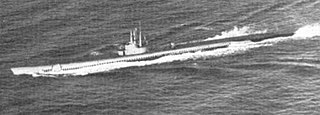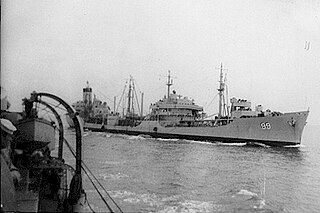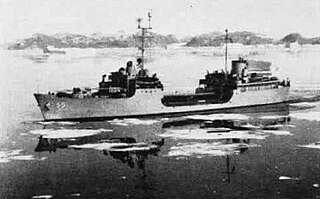
USS Runner (SS/AGSS-476), a Tench-class submarine, was the second ship of the United States Navy to be named for the runner, an amberfish inhabiting subtropical waters.

USS Stickell (DD-888) was a Gearing-class destroyer of the United States Navy in service from 1945 to 1972. She was renamed HS Kanaris (D212) in 1972 on transfer to the Hellenic Navy.

USS Douglas H. Fox (DD-779) was an Allen M. Sumner-class destroyer of the United States Navy.

USS Sea Leopard (SS-483), a Tench-class submarine, was the only ship of the United States Navy to be named for the leopard seal. Her keel was laid down by the Portsmouth Navy Yard on 7 November 1944. She was launched on 2 March 1945 sponsored by Hon. Margaret Chase Smith, United States Congresswoman from Maine, and commissioned on 11 June 1945.

USS Noxubee (AOG-56) was a Patapsco-class gasoline tanker acquired by the U.S. Navy for the task of transporting gasoline to warships in the fleet, and to remote Navy stations. She served in a commissioned status from 1945 to 1959, and 1965–1975. She was named for a river in Mississippi.

USS Barton (DD-722), an Allen M. Sumner-class destroyer, was the second ship of the United States Navy to be named for Rear Admiral John Kennedy Barton.

USS Mount McKinley (AGC-7/LCC-7) was the lead ship of the Mount McKinley class of amphibious force command ships. She was named after the highest mountain in North America. She was designed as an amphibious force flagship, a floating command post with advanced communications equipment and extensive combat information spaces to be used by the amphibious forces commander and landing force commander during large-scale operations.

USS William M. Wood (DD/DDR-715) was a Gearing-class destroyer in the United States Navy during the final year of World War II. She was in commission for 31 years, from 1945 through 1976, serving in both the Pacific and Atlantic Fleets. She was the second Navy ship named for Navy Surgeon-General William M. Wood (1809–1880).

USS Kankakee (AO-39) was a Kennebec-class fleet oiler of the United States Navy. The ship was built as SS Colina by Bethlehem Steel Co., Sparrows Point, Maryland, launched on 24 January 1942, sponsored by Mrs. D. A. Little, acquired for the Navy on 31 March through the Maritime Commission from her owner, Socony-Vacuum Oil Company, New York City, and commissioned as Kankakee at Norfolk, Virginia, on 4 May.
USS Terrebonne Parish (LST-1156), originally USS LST-1156, affectionately nicknamed the "T-Bone" by her early crew, was a Terrebonne Parish-class tank landing ship built for the United States Navy in 1952. The lead ship in her class, she was named for Terrebonne Parish, Louisiana, the only U.S. Navy vessel to bear the name. The ship was later transferred to Spain and renamed Velasco (L-11), and was scrapped in 1994.

USS Aucilla (AO-56) was a Cimarron-class fleet oiler. She was constructed for the United States Navy during World War II and her assignment was to provide liquids, such as fuel or water, to ships in the forward battle areas. She survived this dangerous task and returned home post-war with five battle stars to her credit.

USS Caloosahatchee (AO-98) was a Cimarron-class fleet oiler constructed for the U.S. Navy for use in World War II but commissioned too late for service in that conflict. However, she had a lengthy career during the Cold War that followed. She was the only U.S. Navy ship to bear the name Caloosahatchee, after the Caloosahatchee River in southwest Florida.

USS Canisteo (AO-99) was a Cimarron-class fleet oiler constructed for the United States Navy in the closing days of World War II. Commissioned too late for service in that conflict, she had a lengthy career in the Cold War that followed. She was the only U.S. Navy ship to bear the name Canisteo, after the Canisteo River in New York.

USS Tombigbee (AOG-11) was a Patapsco-class gasoline tanker in service with the United States Navy from 1943 to 1972. She was then sold to Greece, where she served as Ariadni (A414) until 2003.

USS Nespelen (AOG-55) was a Patapsco-class gasoline tanker in the service of the United States Navy.

USS Truckee (AO-147) was a Neosho-class fleet oiler of the United States Navy in service from 1955 to 1994. The ship was named after the Truckee River in the U.S. states of California and Nevada.

USS Fort Mandan (LSD-21) was a Casa Grande-class dock landing ship of the United States Navy, named in honor of Fort Mandan, the encampment at which the Lewis and Clark Expedition wintered in 1804–1805, in what is now North Dakota.

USS Pawcatuck (AO-108) was a T3 Ashtabula class replenishment oiler tanker that served in the U.S. Navy from 1946 to 1975, then transferred to the Military Sealift Command to continue in non-commissioned service with a civilian crew as United States Naval Ship USNS Pawcatuck (T-AO-108). She was the only United States Navy ship to bear the name Pawcatuck.

USS Ruchamkin (APD-89), ex-DE-228, later LPR-89, was a United States Navy high-speed transport in commission from 1945 to 1946, from 1951 to 1957, and from 1961 to 1969. She subsequently served as ARC Córdoba in the Colombian Navy, until 1980; although scrapped, her hull and superstructure were re-erected in a leisure park near Bogotá.

USS Pecatonica (AOG-57) was a Patapsco-class gasoline tanker in service with the United States Navy from 1945 to 1946 and from 1948 to 1961. She was then transferred to the Taiwanese Navy where she served as ROCS Chang Pei (AOG-307/AOG-507) until 2005.



















